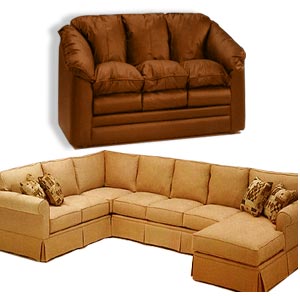Upholstery Fabric

Choose a style for your furniture upholstery, be it traditional or modern, country or contemporary. A prospective upholstery shopper will be daunted by the myriad choices available - patterns, weaves, textures, fiber content and weight of the fabric.
Bear in mind the room decor and other functional aspects before you make your upholstery material choice. If you are considering getting your furniture reupholstered, look up our useful tips to selecting the right upholstery fabric. Find out how to undertake regular upholstery cleaning.
Upholstery fabric
An important consideration when choosing upholstery fabric is its durability. With kids and pets around, you need a durable and sturdy upholstery fabric. Elegant chairs would need different treatment as compared to the family couch. The upholstery fabric must also be appropriate for the furniture it is covering. The design must be balanced to the size of the room. The upholstery must be appropriate to the room and its overall decor (décor). Check the upholstery fabric for resistance to stains, moths and regular wear and tear. Does it fade when exposed to sunlight? If so it is unsuitable for a sunny patio.
Upholstery fabrics come in a wide price range, from $10 to $250 for embroidered silk upholstery. Rich upholstery fabric choices are chenille, suede and leather, jacquard, damask, tapestry and tweed. You can also go in for velvet, satin or silk dupioni. Prints come in florals or contemporary designs or plaids and stripes.
You can choose from natural upholstery fabrics like linen, cotton, silk or leather or opt for man-made fibers such as polyester and rayon. While the classic and elegance of natural upholstery fabrics cannot be denied, man-made fabrics are easier to maintain and resilient. Natural fibers tend to absorb stains faster. You can opt for blended upholstery fabrics that give you the best of both worlds.
- Highly textured fabrics like tweed and velvet can fray with use.
- Solid colored fabrics for upholstery blend well with most decors.
- Cotton upholstery fabric wrinkles soon but is suitable for warmer climates.
- Linen upholstery is strong and durable but is less stain-resistant.
- Woolen upholstery offers warmth in cold climes.
- Polyester and acrylic blend upholstery fabrics are washable and resilient to shrinkage. Some are hypoallergenic too.
- The color of your furniture upholstery material can affect the room décor.
- Polyester upholstery material comes in abrasion-resistant strong fibers.
- Silk upholstery comes in different fibers, ranging from fine to heavy.
Changing the upholstery material can add sparkle to your old furniture and give your room a facelift. Discount stores might be a good idea if you are planning do-it-yourself furniture upholstering with a limited budget. Solid chenille or faux leather, floral chintz or smooth satin – choose your furniture upholstery with care. With the right cleaning and maintenance, it can last you a long time.
Upholstery cleaning
- You can get your precious upholstery fabric fiber-sealed so that it becomes resistant to stains.
- Make slipcovers in tough fabrics so that upholstery cleaning is made easier. This is ideal for dining room chairs where there is every likelihood of stains.
- Rotate cushions on upholstered furniture so that there is even wear. Plump up the upholstered cushions regularly.
- Use only products recommended by the manufacturer on the upholstery material. Some upholstery fabrics need a water-based cleaning solution whilst some others require solvent based solutions.
- Vacuum the upholstered material to remove dust and crumbs.
- Get professional upholstery cleaner to give your rich upholstery fabric the cleaning treatment that is right for it.
- Contain accidental spills by blotting. Using water and detergent may worsen the stain and cause permanent damage to the upholstery material.
- If you find a hole in the upholstery material, trim the edge neatly lest the loose threads get further ripped. This is more so with upholstery fabric that has loops, open or structural weave.
- Dye transfer from dark-colored clothes can take place on white or pale colored upholstery fabric.
Leather upholstery
Leather upholstery adds elegance and luxury to your furniture. Sink into the luxurious comfort of leather upholstered couch or sofa. You can go in for split leather upholstery or embossed leather upholstery. But ensure that you care for your leather upholstery so as to keep it clean and durable. Perspiration and natural oils have an adverse effect on leather upholstery. Wipe your leather furniture regularly.
Top of the Page: Upholstery Fabric
Tags:#upholstery #upholstery fabric #upholstery cleaning #furniture upholstery #upholstery material #leather upholstery
 Home and Garden
Home and Garden Wallpaper Mural
Venetian Blinds
Wrought Iron Furniture
Coffee Table
Table Linen
Beveled Mirror
Platform Beds
Rug Carpet
Home Furnishing Idea
Home Improvement Tips
Drape Fabric
Shower Curtain
Window Curtain
Kitchen Curtain
Discount Home Furnishing Tips
Kitchen Remodeling Idea
Upholstery Fabric
Slipcover
Home Garden Design
Lower Energy Bills
Home Office Furniture
Top of the Page: Upholstery Fabric
Popularity Index: 101,099

